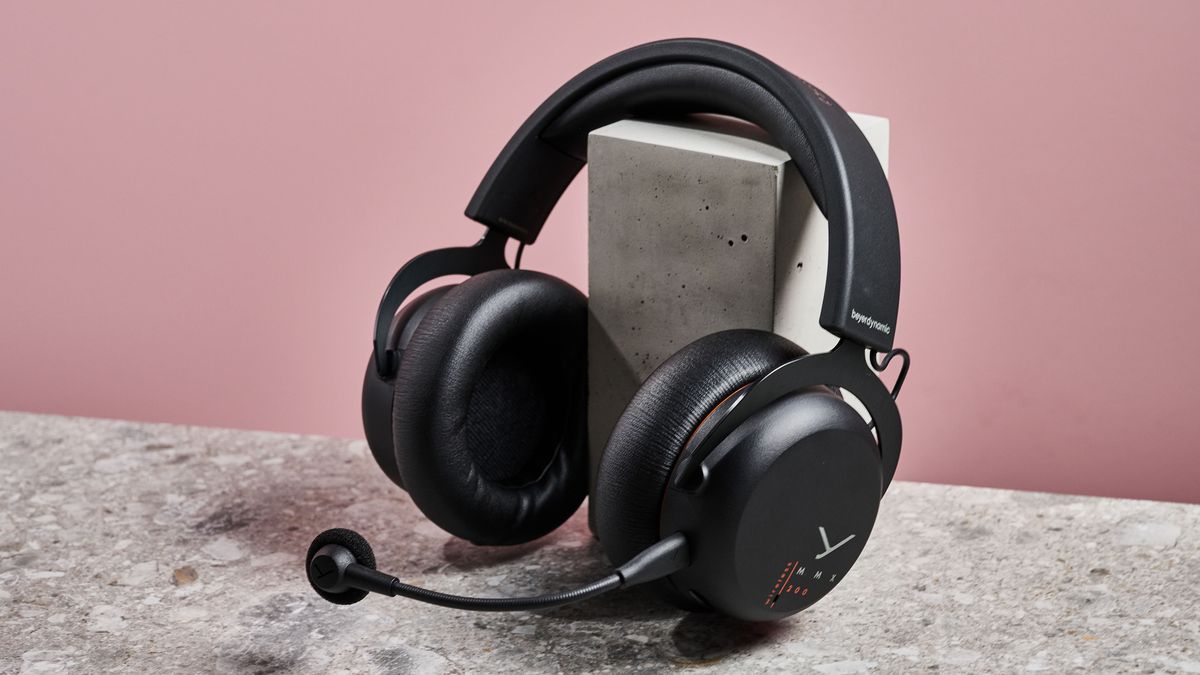Products You May Like
Beyerdynamic MMX 200 Wireless: Two-minute review
The Beyerdynamic MMX 200 Wireless is one of the company’s recent forays into the gaming market, with the brand leaning heavily on its reputation in the professional audio space as it boasts studio-grade sound quality for players.
The MMX 200 Wireless doesn’t exactly cut a slim figure; every aspect of its form is bulky, from the headband to the drivers and even the ear pads, which can get in the way when you lean back in your chair, due to their rounded shape. There’s also no way to fold the drivers away, so you’ll need a good amount of space to store it.
However, the thickness of the padding does elevate comfort levels. Both my ears and head remained comfortable for long sessions, despite the relative heaviness of the MMX 200 Wireless compared to some of the best wireless gaming headsets.
I did experience slight fatigue around the ears after several hours, though, and while the MMX 200 Wireless is generally conducive to glasses wearers, I noticed a slight ache from the arms of my frames being pressed into my head – although this wasn’t as egregious as I’ve experienced with other headsets.
The overall build quality is of a high standard, with the buttons, volume wheel and ports feeling solid yet easy to use. However, the mechanism for adjusting the height of the earcups lacks the same level of engineering.
In use, the MMX 200 Wireless renders sound with the high fidelity it claims. All frequencies are clear and balanced, and while some may find the low-end lacking somewhat, there’s still just enough punch. I did find that using the analog input offered marginally better sound quality, but not substantially. The Low Latency adapter also offers slightly improved response times as claimed; but, again, there isn’t much difference. Another win is Augmented mode, which achieves its aim of letting your voice and ambient noise come through clearly when you want it to.
The microphone, too, is of a high quality. Voices are clear with minimal distortion, although fidelity isn’t overly impressive. Superfluous noises are well blocked, though.
There are a few usability issues with the MMX 200 Wireless. First, connecting wirelessly via Bluetooth or the Low Latency adapter isn’t the most seamless experience, and I experienced issues with various devices failing to connect on my initial attempts. The button required to switch between Bluetooth and Low Latency modes also failed to register consistently, requiring firmer and slower presses than you might expect.
Connecting via USB-C from my PC also resulted in a constant, high-pitched whine, resembling that of electronic interference, which is obviously an annoyance. Thankfully, though, it’s quiet enough to be masked by game audio.
The claimed 35-hour battery life of the MMX 200 Wireless does seem to hold true, as I managed several days of varied use during my time with the headphones. Charging to full from empty takes somewhere under three hours, which is about average.
Although it may have other headsets beat for audio quality, and the multiple connectivity options and handy features work well for the most part, this is a fiercely competitive space, and the MMX 200 Wireless’ various user interface and connectivity flaws mean rival models – such as the Razer BlackShark V2 Pro and the SteelSeries Arctis Nova Pro – offer a better gaming experience for a similar price or less.
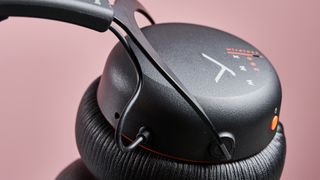
Beyerdynamic MMX 200 Wireless: Price and availability
- $199 / £169 / AU$399
- Released September 28, 2023
- Black and gray variants available
The MMX 200 Wireless costs $199 / £169 / AU$399. It’s available now in two colors: black and gray. The detachable microphone and Low Latency adapter, as well as the USB-C to 3.5mm analog and USB-C to USB-A cables, are all included.
Whichever way you slice it, this is an expensive headset. The Razer BlackShark V2 Pro, one of the best wireless gaming headsets in our view, costs the same at $199 / £199 / AU$349, although it can be found for less. Despite being a few years old at this point, the BlackShark V2 Pro continues to impress with its excellent build and sound quality. It also features Razer’s spatial audio engine, THX, which really does add an extra layer of immersion.
If you’re only concerned about PC gaming and want to spend even less, the Corsair HS65 Surround may be a better choice. It’s our pick as the best PC gaming headset for those on a budget, thanks to its surround sound compatibility and lightweight construction. You can’t go wireless with it, though.
Beyerdynamic MMX 200 Wireless: Specs
| Price | $199 / £169 / AU$399 |
| Weight | 12.7oz / 360g |
| Compatibility | PlayStation 5, PlayStation 4, Nintendo Switch, Xbox Series X, Xbox Series S, Xbox One, PC, mobile |
| Connection type | Wireless (Bluetooth 5.3, Low Latency USB dongle), Wired (3.5mm analog, USB-C to USB-A) |
| Battery life | Up to 35 hours |
| Features | In-line microphone, Low Latency mode, Augmented mode |
| Software | Beyerdynamic Update Hub |
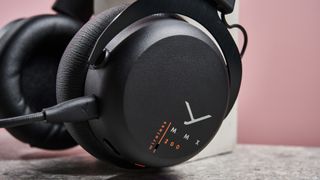
Beyerdynamic MMX 200 Wireless: Design and features
- Bulky design
- Circular cups not ergonomic
- Switchgear feels premium
Unlike other gaming headsets, the MMX 200 Wireless sports a moderate aesthetic, with the flashes of orange adorning the earcups being the only nods to its target market.
It isn’t what you’d call discreet, though, because every part of the MMX 200 Wireless is large. The earpads are thick, which does at least make them comfortable for extended session; it prevents the inside of the drivers from pressing against the ear lobes – something I have experienced with numerous headsets and headphones, including the Beyerdynamic DT770s. Glasses-wearers should also find the MMX 200 Wireless comfortable, although I did notice a slight ache in my temples after a few hours of continuous use, caused by the pressure of the drivers. It’s still far better than I’ve experienced with other headsets, though.
Annoyingly, the circular shape of the drivers means they can press on the back of your chair when you rest back your head. I generally prefer oval-shaped drivers for this reason, usually finding them more comfortable overall. Also, they don’t rotate laterally, which makes stowing them away a chore. This also means the MMX 200 Wireless are a little cumbersome to hang off your neck, but it still isn’t what I’d call uncomfortable in this position.
While the headband padding is well cushioned, I would recommend moving the drivers a little further down than you typically might: I found that failing to do so caused the top of my head to ache. Admittedly, this is an issue I experience with many headphones, so others may not have the same experience.
The mechanism for adjusting the position of the drivers isn’t the most elegant or well made. The notches are overly stiff, and don’t feel the most seamless to operate. Also, the wires coming from the drivers are exposed, whereas they’re generally hidden and protected on other premium gaming headsets.
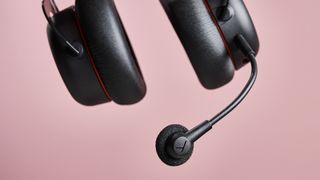
The switches and ports on the MMX 200 Wireless are well made, however. All the buttons feel solid, being firm yet easy to operate. The USB-C and microphone ports are deeply recessed, offering an extra level of assurance that they won’t get damaged, although this is arguably a case of over-engineering. The included cables are also premium, with a thick rubberized casing and solid connections; but their lack of strain-relief could spell trouble in terms of longevity, making them more susceptible to fraying.
The detachable microphone is of a similarly high standard to the rest of the MMX 200 Wireless. The connection to the headset feels very secure thanks to that aforementioned recessing, and the infinitely bendy cable seems very durable yet easy to manipulate, making it a cinch to get in position and out of the way when desired. The cloth cover may be the only weak point in the headset’s design, as it isn’t particularly thick nor cushioned; but it’s on par with other headset microphone cloths.
There are a few extra features on the MMX 200 Wireless. First, there’s Low Latency mode, accessible when using the included dongle, which can connect via USB-C or USB-A. This aims to cut the lag between audio and video, although microphone delay times will still apply.
There’s also an Augmented mode, designed to let ambient sound in more clearly, with the main benefit being a more natural perception of your own voice when speaking. This is achieved by holding the volume button for two seconds. However, the lack of any kind of audio cue means switching in and out of this mode is a little tricky, with testing it being the only way to tell.
There’s no real software for the MMX 200 Wireless, other than an updater tool that can be downloaded from Beyerdynamic’s website. It also tells you whether and how you’re connected to your PC, but provides no other information, not even battery level, which is disappointing. Having a more in-depth tool would have helped to clarify the various modes and states of the MMX 200 Wireless, since it isn’t always obvious from the buttons, LEDs and audio cues alone.
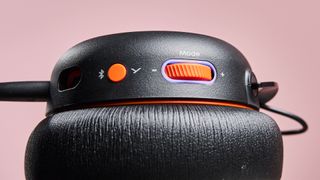
Beyerdynamic MMX 200 Wireless: Performance
- Bluetooth connection clumsy
- High-quality audio
- Low Latency and Augmented modes
Getting started with the MMX 200 Wireless wasn’t the easiest of experiences. Connecting via Bluetooth to various devices took a couple of attempts each time. Pressing the Bluetooth button to switch between Bluetooth and Low Latency adapter modes was sometimes required to kick it into life, and the lack of voice-over stating the mode you’re in made things more difficult.
What’s more, pressing the connection button the correct amount of times to switch between the two modes didn’t always work – presses have to be very deliberate and spaced out in order for mode switching to work. In short, it’s far from being the most efficient process in practice.
Rather worryingly, when I first connected successfully to my PC, the volume was set to 100 by default and I couldn’t change it for the first 30 seconds or so. This could’ve been a quirk of my particular system, and indeed I didn’t experience the same issue when connecting to another PC (Windows 11 instead of 10 this time) or various consoles, but it’s worth mentioning all the same.
Pairing with an Android phone also proved unsuccessful initially. My Google Pixel 7a stated that an incorrect PIN or passkey was the reason for the failure, despite not asking for one (and the impossibility of typing with headset – you’ll be surprised to learn there’s no keyboard function on the MMX 200 Wireless). It did eventually pair with my device, though. I experienced a similar issue connecting to an Android tablet, so perhaps it’s an Android-related issue.
While it’s compatible with the PlayStation 5, you can’t connect via Bluetooth, although this is the case for even the best PS5 headsets. You can connect wirelessly via the Low Latency dongle, though, as well as via the 3.5mm analog jack on the DualSense. Both of these connections were instant and stable.
Connecting to my Nintendo Switch was also straightforward, requiring the lowest number of attempts to establish a connection. Beyerdynamic says that connecting to a Switch is only possible using the Low Latency dongle or the analog cable, but I was able to successfully connect via Bluetooth alone, much like the best Nintendo Switch headsets.
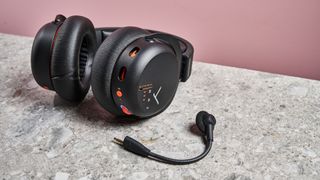
Once you’re connected via Bluetooth, the sound is clear, with all frequencies being very well balanced; there are no muddy mids or harsh highs. There’s also enough power in bass frequencies to lend real impact to in-game music and effects, but it still lacks somewhat in this area compared to other regular headphones, even those made by Beyerdynamic. Still, compared to other gaming headsets, the MMX 200 Wireless performs admirably.
When connected via the analog cable, there does appear to be a slight increase in the presence of higher frequencies, resulting in a sound with a seemingly greater fidelity, although the difference is marginal. It’s much better suited to playing music than some other headsets, too, so if you plan on using the MMX 200 Wireless for various applications, it’s versatile enough to meet your expectations – exactly what you’d expect from a company famed for its attention to sonic detail.
Using the Low Latency adapter does indeed reduce lag, but the effect is only minimal, and I doubt the majority of gamers will ever notice it. Sound quality does seem slightly improved over Bluetooth as well, but again, not by much.
Augmented mode opens up the headset to outside ambience, with the benefit of making your own voice and ambient noises audible. I could even hear the clacking on my keyboard.
The microphone renders voices well, with minimal distortion, although the fidelity doesn’t exactly beat that of other premium headsets. Its claim to block out ambient noises, such as typing, does appear to hold true according to my tests. However, it’s a shame that the Low Latency mode doesn’t appear to have any effect on microphone inputs, since the inevitable delay between speaking and the sound reaching other players remains the same regardless of the mode you’re in.
The claimed battery life of 35 hours does seem to be accurate. I managed to get several days of use out of the MMX 200 Wireless between charges, and that involved using it with multiple devices, connecting to them in all wired and wireless modes. Charging performance is fairly average, with the headset getting back to full from empty in about two and a half to three hours. It’s a shame that there’s no easy way to tell how much battery life remains, though: the light guide around the volume wheel only indicates a few percentage increments, while the voice-over also doesn’t always give an exact figure, so it’s hard to determine remaining levels precisely.
Should you buy the Beyerdynamic MMX 200 Wireless?
Buy it if…
Don’t buy it if…
Also consider…
| Row 0 – Cell 0 | Beyerdynamic MMX 200 Wireless | Razer BlackShark V2 Pro | SteelSeries Arctis Nova Pro |
| Price | $199 / £169 / AU$399 | $199 / £199 / AU$349 | $250 / £250 |
| Weight | 12.7oz / 360g | 11.3oz / 320g | 10.4oz / 296g |
| Compatibility | Xbox, PlayStation, PC, Nintendo Switch, mobile | Xbox, PlayStation, PC, Nintendo Switch, mobile | Xbox, PlayStation, PC, Nintendo Switch, mobile |
| Connection type | Wireless (Bluetooth 5.3, Low Latency USB dongle), Wired (3.5mm analog, USB-C to USB-A) | Wireless (USB-C dongle), wired (USB-C, PC only) | 2x USB-C System Connections, 1x Line-in, 1x Line-out |
| Battery life | Up to 35 hours | Up to 70 hours | N/A (wired) |
| Features | In-line microphone, Low Latency mode, Augmented mode | THX spatial audio, dual connectivity, PlayStation 3D audio | Spatial audio, GameDAC Gen 2 |
| Software | Beyerdynamic Update Hub | Razer Synapse (PC) | GG + Sonar Audio Software Suite |
How I tested the Beyerdynamic MMX 200 Wireless
- Tested for one week
- Tested on multiple platforms and devices
- Plentiful gaming experience
I tested the MMX 200 Wireless for one week. During that time, I used it to game, chat, listen to music and watch video content.
I tested all its features and connection methods. I used it with numerous devices, including PCs (both Windows 10 and Windows 11), a PlayStation 5, a Nintendo Switch OLED, a OnePlus Pad Go tablet and a Google Pixel 7a.
I played both online and offline games, using voice chat in the latter case to test the microphone. I tried to spread my testing across a varied selection of titles, which included Sea of Thieves, Counter-Strike 2, Gran Turismo 7, The Legend of Zelda: Tears of the Kingdom, and Hollowbody.
I have experience testing audio devices, including headphones and speakers, as well as other gaming peripherals, such as mice and keyboards. I also own a pair of Beyerdynamic DT770s, and have used them for audio production for several years. I have been an avid gamer for decades.
First reviewed October 2024.
